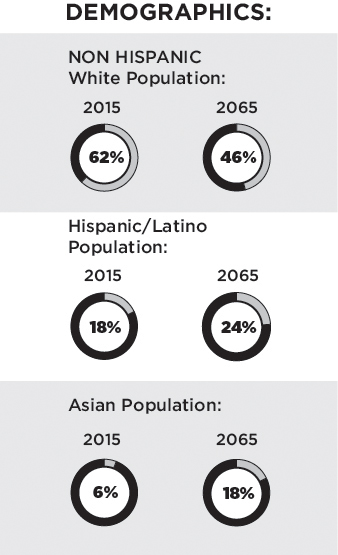A Pew Research Center study analyzed the immigration population from 1965 to 2015 and predicts that Asians will surpass Latinos by 2065.
Predicted Projection
The report gives an overview from 1965 to 2065 and the effects of immigration on the nation’s demographics after the passing of the 1965 Immigration and Nationality Act. The predicted projection from 2015 to 2065 is based on detailed assumptions from trends of births, deaths and immigration levels.
The study found 47 percent of immigrants living in the U.S. are Hispanic, but since immigration from Latin America has slowed in recent years, the Hispanic foreign-born populace is expected to fall to 31 percent. This contrasts with the Asian foreign born populace that is to increase to 38 percent.
Respose to the Growth
The country’s overall population will look differently than that of whites, who are predicted to go from 62 to 46 percent, Hispanics from 18 to 24 percent and Asians from 6 to 14 percent by the year 2065.
Glen Kinoshita, director of multiethnic programs and development, is more concerned with responding to the growth than the actual growth itself.
“I don’t really have an issue with the growth, what I have concerns with is how do we, as a church and as a school respond adequately in becoming a more inclusive place as well as effective, you know, as our mission of equipping people to influence the world,” Kinoshita said.
Following Christ
Kinoshita mentioned that the Bible talks about welcoming foreigners and embracing those who are different. Biola’s response should be one that follows Christ.
“The heart and soul of who we are as believers, we should internally be embracing this and cultivating this because of what the Bible says and because the kingdom of God,” Kinoshita said.
Reactions
Students’ reactions range from surprise to indifference regarding the shift of the immigration population.
“When I think of Asian families, I think of like one or two people … a lot of people I know that are Latino or Hispanic, they have a lot of people in their family. My one friend has like five siblings, for me that’s just a surprising statistic knowing the people that I personally know,” said Kelli Yoon, senior visual media major.
Some students are indifferent to the projections because it either seems evident or because all people groups should be welcomed into the United States regardless of their ethnicity or origin.
“I don’t think it’s a bad thing. I love cultures and I think that’s important and I think America is built on it and so I mean, the more the better,” said Rachel Diaz, freshman cinema media and arts major.
Inevitable
The projections seem inevitable since the ratio of Asians will be greater compared to that of Latinos, according to the Pew Research prediction.
“Statistically it make sense because there’s a lot more Asians than hispanics in the world, so I guess [I’m] indifferent,” said Sun Hwang, senior biology major.
Kinoshita further emphasized how these projections can either help or hinder, greatly depending on the church’s and Biola’s reaction.
All are Immigrants
“Unless we are Native Americans, we all come from an immigrant background. It is the vast majority of our family history and it’s contributing to the reality of diversity in our country, which is a challenge, but it can be one of the greatest assets of the church and Biola,” Kinoshita said.







